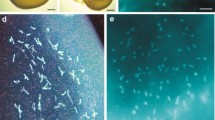Abstract
Both parasitic and free-living females of a calf strain of Strongyloides papillosus have a chromosome number of 2n=4. Both forms reproduce by diploid parthenogenesis. Oocytes of parasitic females undergo only one homeotypic maturation division without homologous chromosome pairing (mitotic parthenogenesis). Oocytes of free-living females show normal pairing and disjunction of the homologous chromosomes, but only one diploid polar body is expelled (meiotic parthenogenesis). Reconstitution of the diploid chromosome number occurs by separation of the two sister chromatids of each univalent during or after anaphase I.
Similar content being viewed by others
References
Bezubik, B.: Failure to establish infection in rats and guinea pigs exposed to the larvae of Strongyloides papillosus. Acta parasit. pol. 13, 349–354 (1965).
Bolla, R.I., Roberts, L.S.: Gametogenesis and chromosomal complement in Strongyloides ratti (Nematoda: Rhabdiasoidea). J. Parasit. 54, 849–855 (1968).
Chang, P.C.H., Graham, G.L.: Parasitism, parthenogenesis and polyploidy: the life cycle of Strongyloides papillosus. J. Parasit. 43, 13 (1957).
Hansen, E.L., Buecher, E.J., Cryan, W.S.: Strongyloides fülleborni: environmental factors and free-living generations. Exp. Parasit. 26, 336–343 (1969).
Katz, F.F.: The effect of irradiation on reproduction by the heterogenetic generation of Strongyloides papillosus. I. Irradiation of males and females. J. Parasit. 46, 383–391 (1960).
Little, M.D.: Experimental studies on the life cycle of Strongyloides. J. Parasit. 48, 41 (1962).
Matoff, K.: Beobachtungen über die larvale Entwicklung von Strongyloides papillosus (Wedl, 1856) und Infektionsversuche mit filariformen Larven. Z. Parasitenk. 8, 474–491 (1936).
Nigon, V.: Les modalités de la reproduction et le déterminisme du sexe chez quelques Nematodes libres. Ann. Sci. Nat. Zool. 11e Sér., 1–132 (1949).
Nigon, V.: Développement et reproduction des Nématodes. In: Grassé P.-P., Traité de zoologie, tome IV (fasc. II). Paris: Masson et Cie. 1965.
Nigon, V., Brun, J.: L'évolution des structures nucléaires dans l'ovogenèse de Caenorhabditis elegans Maupas 1900. Chromosoma (Berl.) 7, 129–169 (1955).
Nigon, V., Roman, E.: Le déterminisme du sexe et le développement cyclique de Strongyloides ratti. Bull. Biol. France Belg. 86, 404–448 (1952).
Restani, R., Borrelli, D.: Osservazioni sulla infestazione sperimentale del vitello con Strongyloides papillosus. Parassitologia 13, 313–319 (1971).
Varjú, L., Németh, I.: Strongyloides-Studien.III. Kreuzzüchtungsversuche mit den in der Außenwelt lebenden sexuellen Individuen von Strongyloides ransomi Schwartz und Alicata, 1930, und Strongyloides papillosus (Wedl, 1856). Acta vet. Acad. Sci. hung. 13, 301–305 (1963).
Author information
Authors and Affiliations
Additional information
This investigation was supported by the Consiglio Nazionale delle Ricerche (C.N.R.) of Italy.
Rights and permissions
About this article
Cite this article
Zaffagnini, F. Parthenogenesis in the parasitic and free-living forms of Strongyloides papillosus (Nematoda, Rhabdiasoidea) . Chromosoma 40, 443–450 (1973). https://doi.org/10.1007/BF00399433
Received:
Issue Date:
DOI: https://doi.org/10.1007/BF00399433




